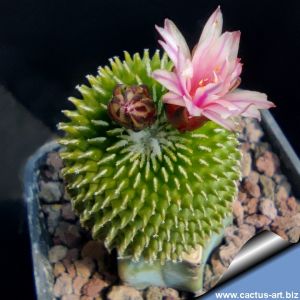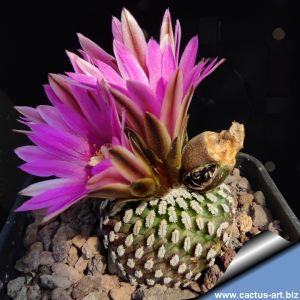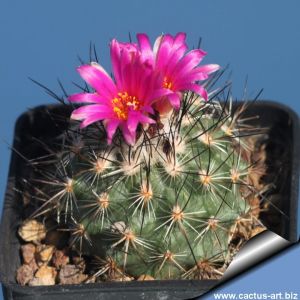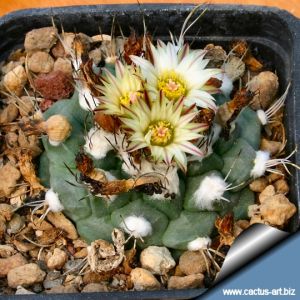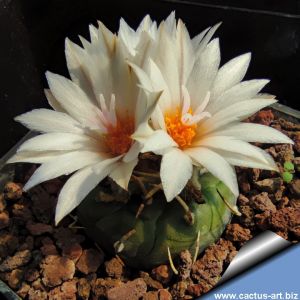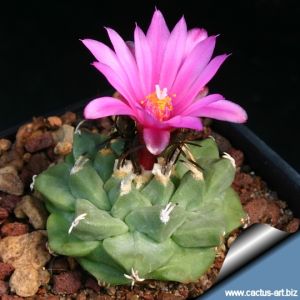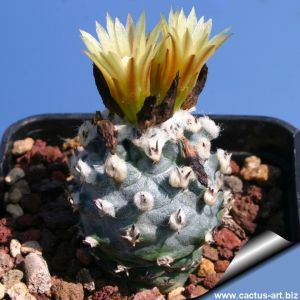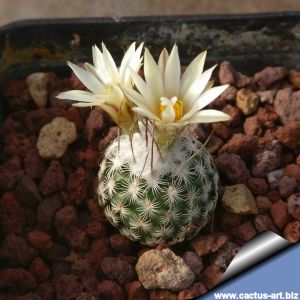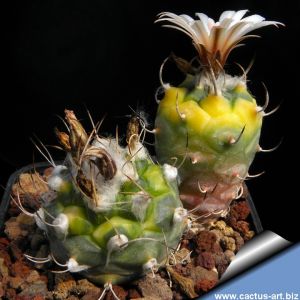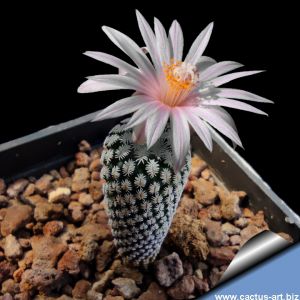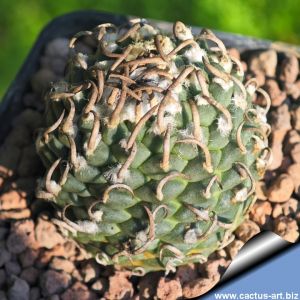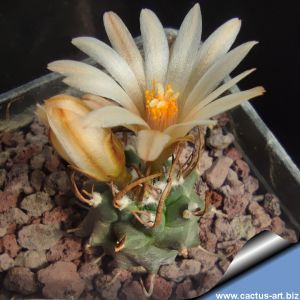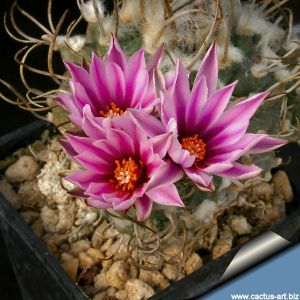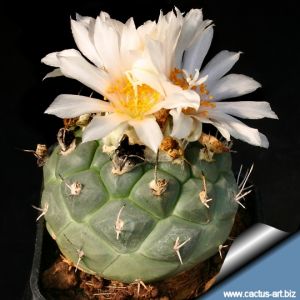-
1
A tiny spineless form with spherical growth habit that slowly branches producing small clusters. Grafted on short Myrtillocactus.
-
2
Turbinicarpus pseudopectinatus is an extraordinary cactus with many small spirally-arranged tubercles tipped with tiny white spines in a comb like formation. Flowers are pinkish white to bright pink with darker magenta or reddish-brown mid-veins.
-
3
Turbinicarpus mombergeri is a naturally occurring hybrid between T. pseudopectinatus and T. laui. This plant pass a pectinate-plumose spine stage in which they are already floriferous. Most of the plants in time develop longer spines. It is quite variable
-
4
(Syn.: Pelecyphora pseudopectinata f. inermis) A dwarf, spineless cultivar with a globular shape and slow growth. The complete absence of spines and the symmetrical, small axe-shaped tubercles make it unique. Three-year-old seedlings.
-
5
-
6
-
7
-
8
T. klinkerianus stands out for its pyramid-shaped tubercles and short spines (just 3 per areole), which have a soft, corky texture and transverse fissures—typically reduced to one in adult plants. Its ivory-white flowers display subtle magenta veining.
-
9
-
10
Gracefully elongated in shape, featuring radial white spines and dark central spines. Its flowers range from pale butter-yellow to rich pink, offering a beautiful color gradient.
-
11
Turbinicarpus alonsoi is a small cactus with a large tap-root, and only the apical part of the stem exposed at soil level. The spines are flattened, cardboard-like, grey with dark tip, irregularly bent inwards, frequently weathered, not piercing.
-
12
This is a very distinctive short spined variant of the famous Turbinicarpus flaviflorus. This variety has very short corky golden-brown spines that contrast well with the body which is coated in a whitish bloom.
-
13
Tiny cacti with pretty long, curly and flexible central spines. They bear nice white flowers even on cm young specimens. Exceptionally beautiful plants!
-
14
A small, slow-growing cactus with a blue-green to olive stem arising from a thickened, fascicled root. Radial spines are straight, rigid, interwoven, brown turning grey-white with dark tips. Flowers are deep purple with a pale throat.
-
15
Turbinicarpus schmiedickeanus ssp. dickisoniae is similar to Turbinicarpus schmiedickeanus ssp. gracilis the closest variety. Radials spines 18-24 white 2mm long on young areoles (areole in old specimens have only central spines).
-
16
Gymnocactus beguinii is a small usually solitary, globose cactus with magenta funnel-shaped flowers. The anthers are dark chrome yellow. The style is creamy white.
-
17
Variegated plants have sectors, patches or stripes with two or more colours. Plants with variegated body are highly prized. Very variable.
-
18
Stem dark green-bluish, semi-globose, depressed, divided into tubercles, merging in a tuberous root 3-5 cm long. The flowers are light cream to slightly pinkish, with reddish throat. They bloom very early in winter (January-February in Europe)
-
19
Syn: Turbinicarpus schmiedickeanus v. rubriflorus
-
20
Initially bearing only short white pectinated spines, it matures into producing long twisted central spines. Early blooming, even young plants display beautiful cream flowers with pink striping.
-
21
Piante minuscole (max 20-35 mm), con tubercoli piramidali a 4 spigoli, verde glauco a ocra. Radice napiforme. Spina singola, cartacea con cuticola screpolata, e curva verso l'apice della pianta. Fiori bianchi con venatura centrale rosa o magenta pallido.
-
22
Tiny grey tubercled body with upward-curving corky spines. Cream-colored flowers. A miniature treasure.
-
23
Dazzling blooms in hot pink, each petal marked by a sharp purple midline. A jaw-dropping color, Absolutely breathtaking!
-
24
A stunning species discovered in 2015, closely allied to T. alonsoi. Features striking tubercle structure, soft white spination, and vivid magenta blooms. It thrives on steep gypsum and limestone rock faces.
-
25
One of the most interesting Turbinicarpus species, bearing very large white or pale pink flowers. Solitary, globular, blue-green but depressed body, with woolly apex. Short, low, rounded tubercles give it a look similar to a small Lophophora.
-
26
A nice form with a larger stem and elegant white flowers.
-
27
A nice form featuring a green-bluish body, short, stiff, white spines, and striking large white flowers.
-
28
Buds concealed in woolly crowns erupt into flowers more vividly colored than typical schwarzii. Pink petals with magenta midribs create iridescent depth. A chromatic upgrade that makes this variety stand out in any collection.
-
29
Miniature pagoda-like stem with stacked conical tubercles. 4 soft, cork-like spines and unique yellowish-green flowers (2-3cm). The Latin name literally means "yellow-flowered", highlighting its most prized feature.
-
30
Plant with pale green epidermis. Tubercles are flattened, four-angled (diamond-shaped), broad and stumpy. Bears 1–3 spines per areole, one notably longer. Flowers are white.
-
31
Compact and rounded, this bluish-grey cactus features broad white woolly areoles and slender, curved spines of glassy white with darker ends. It produces clusters of vivid pink flowers at the top, making it highly decorative.

